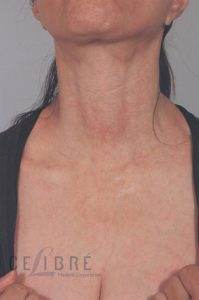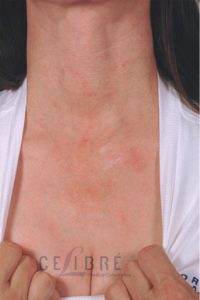Chances are you’ve seen poikiloderma—you just didn’t know what it was! Poikiloderma is the discoloration of the neck and chest that can happen after years and years of sun exposure. That’s right…Poikiloderma is a very specific form of sun damage. It occurs on the sides of the neck (not on the front, which is shadowed by the chin) and the chest, usually where the shirt and collar don’t cover the skin.


Causes of Poikiloderma
Here in sunny Southern California, poikiloderma occurs in both men and women. Although many of us remember to wear sunscreen on our faces, we often neglect the neck and chest. As a result, and over the years, these areas accumulate sun damage Poikiloderma rears its ugly head, mostly in our thirties and forties.
Symptoms and Appearance
Now that you know the name, where it happens, and what causes it, you may wonder why it looks the way it does? The redness that is a hallmark of Poikiloderma occurs from the development of tiny blood vessels near the surface of the skin. It may look like a permanent sunburn and blanche (turn white) when you press on it. Unlike a temporary sunburn, it never goes away and doesn’t hurt. The brown discoloration is due to the overproduction of melanin (pigment) in response to sun exposure. Lastly, the textural changes that come with poikiloderma can include a thickened, leathery look or a roughened, bumpy-looking appearance. This happens due to the sun’s damaging effect on collagen and elastin in the skin.
Why Creams and Sunscreen Aren’t Enough
We’ve seen many patients with poikiloderma who’ve tried and failed creams, potions and exfoliants to get rid of it. Worse yet, many of them believe that if they start wearing sunscreen, it will fade with time. Unfortunately, once poikiloderma develops, it is a long term change in your skin that’s challenging to treat.
Effective Treatments for Poikiloderma
The most effective treatment for this common skin condition is medical lasers. Using lasers such as pulsed dye, q-switched and BBL (IPL), we can effectively remove much of the pigmentation associated with Poikiloderma. A series of treatments is usually necessary for you to see best results. Like many other skin conditions, you will need to practice good sun avoidance and start using sunscreen to avoid poikiloderma from coming back once it’s been successfully treated.

